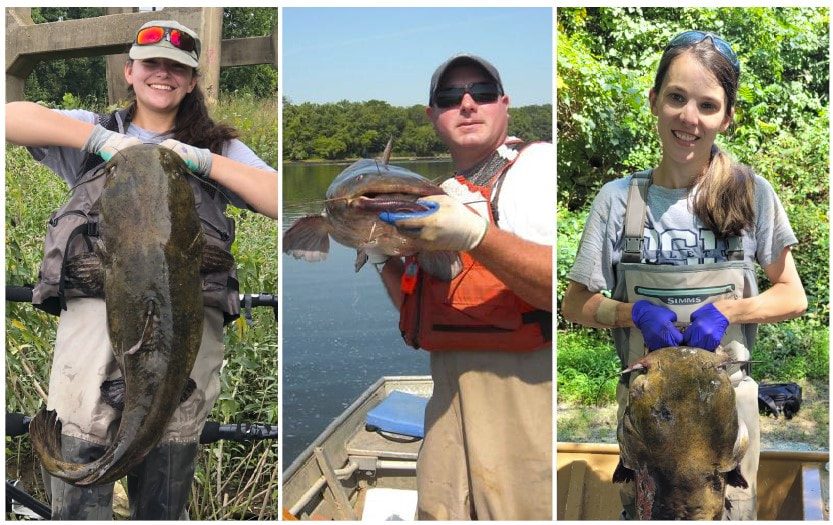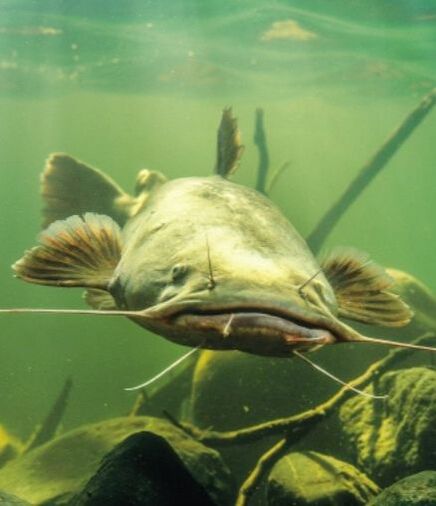|
Surrounded by the pungent odor of rotting fish flesh and other organic matter, Penn State research student Sydney Stark meticulously dissects the contents of flathead catfish from the Susquehanna River basin in an attempt to better understand what they eat and how the invasive species impacts the aquatic ecosystem. “Flatheads have a very fast metabolism rate, so it can be really hard to identify prey species inside of their stomachs because they are so degraded,” said Stark. “We have begun incorporating molecular analysis via DNA to better identify what we are finding.” Her findings so far indicate a very diverse diet with more than 30 species represented.
Geoff Smith, an aquatic biologist with the Pennsylvania Fish and Boat Commission who has been heavily involved in this sort of research agreed.
“There is a common analogy in our world that you can’t manage what you don’t measure,” he said. “A lot of this is collecting the type of data we need to understand not only what is going on, but what we can potentially see going on in the future in other places.” Invasive invaders Flathead catfish are not native to the Susquehanna River basin. The first known report of one in the watershed was in 2002 when an angler caught a flathead catfish near a Lancaster County dam. “The accepted origin of the species in our river is from anglers who purposely introduced them to create a sport fishing element. We know of a separate introduction in the North Branch near Wilkes-Barre,” said Smith. “They’ll likely meet in the middle at some point. We have record of them in certain tributaries, too, like the Juniata River.” According to Schall, there is a certain recreational allure for having flatheads in our river system. “It is a fish that can exceed 50 pounds, and the opportunity to catch something that large is unique for the Susquehanna,” she said. “However, it is also a top predatory fish that can eat a lot of other species in the basin and competes for habitat with them.” “It definitely comes at a cost,” Smith agreed. “A 50-pound fish doesn’t just get that way without a massive amount of eating, and that comes at the expense of the fish biomass of the river.” Citing an example from flatheads that were introduced decades ago in Cape Fear River in North Carolina, Stark suggested that the species can be very adaptable and rapidly take over a stretch of waterway. “Eleven individuals were initially released, and within 15 years, they had grown into a really substantial population that was taking over as one of the dominate predators of the river,” she said. “They are able to feed on very large fish because they have a wide mouth. They also compete with other predator species, pushing them out of the area.” One of those adaptions, according to Smith, was noticed in a population at the Fairway Dam near Philadelphia. “Flatheads move in and actually camp out waiting for migratory fish to work around the dam. They have learned it is an aggregation point, and they just hang out there during spawning season and make the most of the situation,” he said. “It is very unique from a species standpoint that they have this sort of learned behavior.” Spread in the Susquehanna Since the first report in the Susquehanna system in 2002, flatheads have been found in a rapidly growing area of the watershed. “Distribution has included 155 miles upstream of that original site and 31 miles downriver,” said Schall. “They’ve been found in one of the Susquehanna River’s major tributaries – the Juniata River – as far out as 108 miles. This shows that in just a relative short amount of time the potential for movement in the system.” While Smith has not personally confirmed any flatheads in the West Branch of the Susquehanna yet, he has started getting some reports of their presence. “I am not sure why they haven’t been as quick to move up the West Branch, although they don’t seem to like cold water and the lower West Branch has some limestone streams come in near the mouth and that may be enough of a signal that they don’t prefer,” he said. “However, as the habitat around them becomes more saturated (with flatheads), the urge to push into the West Branch may be more rapid.” The spreading – and growth rate increases – provide two important red flags that have been seen in other systems previously invaded by flatheads. “As they move upstream and they expand their range, we tend to not see as large of fish because they haven’t reached their max yet,” Smith said. “Working close to Selinsgrove, in the past two studies, we’ve seen flatheads in the 20 to 25-pound range which I did not see just four years ago. Back then, a large fish was more like 10 to 15 pounds. That steady progression is what we’ve seen in systems to our south and will likely only increase as they continue their expansion.” Expanding awareness Flatheads are concerning because they lack natural predators in our system and other species have not evolved with them as well as they have in other rivers where they are native. However, a response to their growing prevalence is not simple, Schall suggested. “Unfortunately, this invasive species is not going anywhere. We talked before about getting rid of flatheads and it is not a feasible option,” she said. “So, we are working to better understand them, their impact and our methods of studying the species.” Flatheads are being used as a tool to better understand emerging contaminants – such as PFAS (forever chemicals) in our waterways. “We have partnered with the USGS in collecting water samples to look at potential sources of certain emerging contaminants, as well as various fish tissues from flatheads and other species,” Schall said. “In flatheads, we are interested in collecting muscle because when people catch flatheads, that is what they’d be eating. However, we also are looking at contaminant levels in their blood.” This sort of work is essential not only to better understand flatheads, but interconnections in the ecosystem, Schall added. “We are building pieces of understanding, and we want to learn more and more about not just flatheads, but also communities, how various organisms are interacting and eventually about how people play a role in this all, especially when we start looking into new emerging contaminants.” Along those lines, anglers and the public in general are important resources for the work done by Schall, Smith, Stark and others. “We released a survey to find out what people are seeing and also to spark communication with the public,” Schall said. “Sometimes, we get some of our first information from people like that on the water, and that sort of information is essential to our work. I love my streamside chats with people about flatheads and other species because I learn so much that way.” If you see a situation where an invasive may be entering our system, report it. The Pennsylvania Fish and Boat Commission has an online reporting form available on its aquatic invasive species page: www.fishandboat.com/Resource/AquaticInvasiveSpecies/Pages/default.asp
0 Comments
Leave a Reply. |
AuthorsRiverkeeper John Zaktansky is an award-winning journalist and avid promoter of the outdoors who loves camping, kayaking, fishing and hunting with the family. Archives
April 2024
Topics |


 RSS Feed
RSS Feed